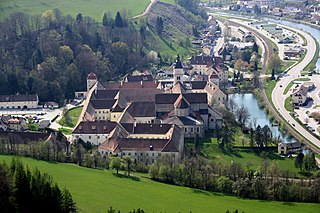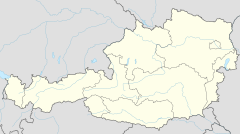
Melk is a city in the Austrian state of Lower Austria, next to the Wachau valley along the Danube. Melk has a population of 5,257. It is best known as the site of a massive baroque Benedictine monastery named Melk Abbey.

Dürnstein is a small town on the Danube river in the Krems-Land district, in the Austrian state of Lower Austria. It is one of the most-visited tourist destinations in the Wachau region and also a well-known wine growing area. The municipality consists of the Katastralgemeinden of Dürnstein, Oberloiben, and Unterloiben.

The Schottenkirche is a parish church in Vienna attached to the Schottenstift, founded by Irish Benedictine monks in the 12th century. In 1418, the Duke Albert V of Austria transferred it to the German-speaking Benedictine monks from the Melk Abbey during the Melker Reform initiated after the Council of Constance. The church was elevated to the rank of Basilica Minor in 1958.

Kremsmünster Abbey is a Benedictine monastery in Kremsmünster in Upper Austria.

Göttweig Abbey is a Benedictine monastery near Krems in Lower Austria. It was founded in 1083 by Altmann, Bishop of Passau.

Seckau Abbey is a Benedictine monastery and Co-Cathedral in Seckau in Styria, Austria.

Nonnberg Abbey is a Benedictine monastery in Salzburg, Austria. Founded c. 712/715 by Saint Rupert of Salzburg, it is the oldest continuously existing nunnery in the German-speaking world. The monastery complex is today a protected monument and part of the Historic Centre of the City of Salzburg, a UNESCO World Heritage Site since 1996.

Admont Abbey is a Benedictine monastery located on the Enns River in the town of Admont, Austria. The oldest remaining monastery in Styria, Admont Abbey contains the largest monastic library in the world as well as a long-established scientific collection. It is known for its Baroque architecture, art, and manuscripts.

St Peter's Abbey, or St Peter's Archabbey, is a Benedictine monastery and former cathedral in the Austrian city of Salzburg. It is considered one of the oldest monasteries in the German-speaking area, and in fact the oldest with a continuous history since its foundation in 696.

Altenburg Abbey is a Benedictine monastery in Altenburg, Lower Austria. It is situated about 30 kilometres (19 mi) to the north of Krems an der Donau in the Waldviertel. It was founded in 1144,by Countess Hildeburg of Poigen-Rebgau. Throughout its history it suffered numerous invasions and attacks, and was destroyed by the Swedes in 1645. Under Emperor Joseph II in 1793 the abbey was forbidden to accept new novices, but unlike many others in Austria it succeeded in remaining functional.

Seitenstetten Abbey is a Benedictine monastery in Seitenstetten in the Mostviertel region of Lower Austria.

Saint Paul's Abbey in Lavanttal is a Benedictine monastery established in 1091 near the present-day market town of Sankt Paul im Lavanttal in the Austrian state of Carinthia. The premises centered on the Romanesque monastery church were largely rebuilt in a Baroque style in the 17th century.

Michaelbeuern Abbey is a Benedictine monastery in Dorfbeuern near Salzburg in Austria.

Wilhering Abbey is a Cistercian monastery in Wilhering in Upper Austria, about 8 km (5 mi) from Linz. Stift Wilhering is the oldest Cistercian monastery in Upper Austria. The buildings, re-constructed in the 18th century, are known for their spectacular Rococo decoration.

Lilienfeld Abbey is a Cistercian monastery in Lilienfeld in Lower Austria, south of Sankt Pölten.

St. Florian Monastery is an Augustinian monastery in the town of Sankt Florian, Austria. Founded in the early ninth century, and later refounded by Augustinians in the eleventh century, St. Florian is the largest monastery in Upper Austria, and rivals Melk Abbey and Klosterneuburg Monastery as among the most impressive examples of Baroque architecture in Austria. The monastery is dedicated to Saint Florian, whose fourth century grave lies beneath the monastery.

Herzogenburg Monastery is an Augustinian monastery located in Herzogenburg in Lower Austria. Founded in 1112 by Augustinian Canons, the monastery was refurbished in the Baroque style in 1714 by Jakob Prandtauer, Johann Bernhard Fischer von Erlach, and Josef Munggenast.

Paul Troger was an Austrian painter, draughtsman, and printmaker of the late Baroque period. Troger's illusionistic ceiling paintings in fresco are notable for their dramatic vitality of movement and their palette of light colors.

The Wachau is an Austrian valley with a picturesque landscape formed by the Danube river. It is one of the most prominent tourist destinations of Lower Austria, located midway between the towns of Melk and Krems that also attracts "connoisseurs and epicureans" for its high-quality wines. It is 36 kilometres (22 mi) in length and was already settled in prehistoric times. A well-known place and tourist attraction is Dürnstein, where King Richard I of England was held captive by Leopold V, Duke of Austria. The architectural elegance of its ancient monasteries, castles and ruins combined with the urban architecture of its towns and villages, and the cultivation of vines as an important agricultural produce are the dominant features of the valley.

The Melk Abbey Library, also known as the Library of Melk Abbey, is an Austria-based monastic library located in Melk, Austria. The library has many rare medieval manuscripts, as well as a large inventory of Baroque literature.















































